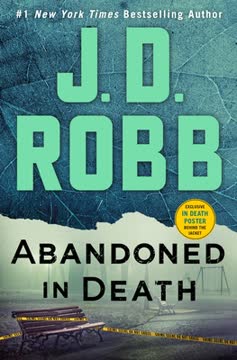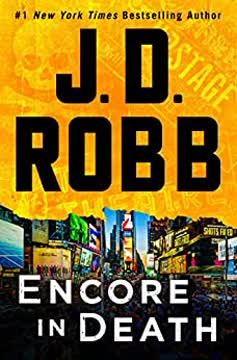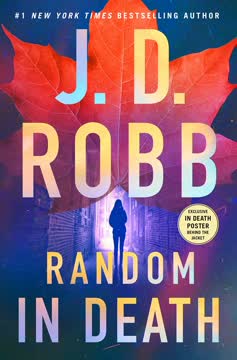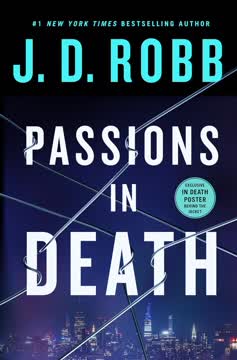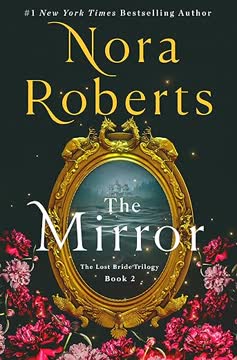Plot Summary
Broken Mothers, Broken Sons
The story opens with a desperate, addicted mother, Lisa McKinney, contemplating suicide and whether to take her young son with her. Ultimately, she leaves him at a church and disappears, her mind and life shattered by trauma and addiction. The boy, traumatized and abandoned, is left to the mercy of the world. Decades later, in 2061 New York, a new horror emerges: young women are being abducted, held, and murdered, their bodies left in public places with the label "Bad Mommy". The narrative sets up a parallel between the brokenness of mothers and the wounds they inflict on their children, wounds that can fester into something monstrous.
The First Body Found
Lieutenant Eve Dallas is called to a playground where a young woman's body has been left on a bench, hands folded over a childish sign reading "Bad Mommy". The victim, Lauren Elder, has been meticulously cleaned, dressed in outdated, flashy clothes, and made up to resemble someone else. The crime scene is both a message and a puzzle, with the killer's obsession with mothers and perfection immediately apparent. The investigation begins, with Eve and her team noting the victim's recent piercings, tattoo, and the careful staging of the body.
Patterns in the Dark
Eve and her partner Peabody dig into Lauren Elder's life, finding no obvious enemies or reasons for her abduction. The killer's pattern emerges: he holds his victims for days, transforms them physically, and then kills them with precision. The lack of sexual assault, the careful washing, and the postmortem beautification all point to a killer obsessed with control and image. The team consults with profiler Dr. Mira, who suggests the killer is recreating a mother figure from his past, driven by both love and rage.
The Next to Vanish
As the investigation intensifies, another young woman, Anna Hobe, goes missing. She fits the same physical profile as Elder—young, blonde, working nights in a bar, living in the same area. The team realizes the killer is hunting in a specific territory, stalking women who resemble his ideal. The urgency increases as they realize Anna is likely being held and transformed, her fate tied to the killer's twisted need for a perfect "mommy."
The Hunt for Anna
Despite their efforts, Anna's body is found outside a children's educational center, staged like the first. She bears the same tattoo, piercings, and careful makeup, but the killer's anger is more evident—her throat is cut from behind, her restraints more brutal. The team is devastated by the loss, knowing they were close but not close enough. The killer's pattern is confirmed: he abducts, holds, transforms, and kills, always leaving the body as a message about failed motherhood.
The Mother's Shadow
Eve's team, with the help of journalist Nadine and tech prodigy Jamie, uncovers the identity of the woman the killer is trying to recreate: Lisa McKinney, a troubled Southern woman who vanished decades ago. She reinvented herself as Violet Fletcher, married a wealthy doctor, and lived a new life, leaving her first son behind. The killer is revealed to be Andrew Dawber, a forensic chemist for the NYPSD, who was abandoned as a child and never recovered from the trauma. His obsession with his mother's abandonment and reinvention drives his crimes.
The Science of Obsession
Dawber's position as a police chemist allowed him to manipulate evidence and stay ahead of the investigation. His meticulous records, scientific approach, and ability to blend in made him an unlikely suspect. The team discovers he has been planning his crimes for months, selecting victims, tracking their routines, and preparing his lair with the tools needed to transform them into his lost mother. His dual nature—precise scientist and raging child—makes him both dangerous and unpredictable.
The Trap Tightens
With the help of forensic and procedural detail, surveillance, and Dawber's own mistakes (notably, a fake nail kit purchase), Eve's team identifies him and locates his new house, bought with money left by his mother. Inside, Mary Kate Covino, his latest victim, uses her wits and courage to manipulate Dawber, playing the role he demands while searching for a way to escape. The team prepares a tactical assault, determined to save her before she becomes the next "Bad Mommy".
The Survivor's Grit
Mary Kate seizes a moment of opportunity, using Dawber's childish need for games to get access to his keys and a weapon. As the police breach the house, she is able to free herself and is rescued, traumatized but alive. Dawber is arrested after a brief, pathetic attempt to flee, alternating between childish tantrums and cold calculation. The evidence in his house—detailed logs, photos, and plans for future victims—cements his guilt.
The Truth About Violet
The investigation uncovers the full story of Lisa/Violet. After abandoning her son, she suffered amnesia and was taken in by a kind doctor, eventually marrying him and building a new life. When her husband died, the trauma of her past returned, and she reached out to her lost son, leaving him a house and money in an attempt at redemption. Overwhelmed by guilt, she took her own life, unwittingly triggering Dawber's final break and his killing spree.
The Labyrinth of Evidence
Eve and her team meticulously document Dawber's crimes, his psychological profile, and the connections between his victims and his mother. The evidence is overwhelming: his own records, the physical evidence, and the survivor's testimony. The team also uncovers that Dawber had begun to research his half-siblings, suggesting he might have expanded his killing if not stopped.
The Final Confession
In a tense interrogation, Dawber alternates between childish outbursts and calculated denials, but ultimately confesses in detail to his crimes. Dr. Mira's expert evaluation confirms that while Dawber is deeply disturbed, he is not legally insane—he knew right from wrong and planned his crimes with chilling precision. The case is closed, but the emotional toll on all involved is profound.
The Cost of Closure
Mary Kate Covino is reunited with her family, her strength and resourcefulness celebrated by the police. The team reflects on the pain and damage caused by broken families, addiction, and abandonment. Dawber's colleagues struggle with the revelation of his true nature, and Eve is forced to defend her team and the lab from blame. The survivors begin the long process of healing, while the police find solace in having stopped a monster.
The Aftermath of Survival
The story closes with Eve and her friends gathering, finding comfort in each other and in the small victories of life. The legacy of pain left by Dawber and his mother lingers, but so does the resilience of those who survived. Eve and Roarke, in particular, reflect on their own broken pasts and the families they have built, determined to break the cycle of pain.
The Legacy of Pain
The final chapter underscores the novel's central theme: the damage parents inflict on their children can echo for generations, but it is possible to break the cycle. Through courage, love, and justice, the survivors and the police forge a new path, refusing to let the sins of the past define their future.
Characters
Eve Dallas
Eve is a homicide lieutenant in 2061 New York, known for her toughness, intelligence, and deep emotional scars from childhood abuse and abandonment. Her own history with a monstrous mother and a broken childhood gives her unique insight into the psychology of both victims and killers. Throughout the case, Eve's empathy for the lost and her refusal to give up drive the investigation forward. Her relationship with her husband Roarke and her found family of friends and colleagues provide her with the support she needs to face the darkness.
Roarke
Roarke is Eve's husband, a self-made billionaire with a criminal past and a genius for technology and business. He serves as Eve's confidant, tech expert, and emotional support, helping her navigate both the practical and psychological challenges of the case. His own history of loss and reinvention mirrors that of the killer's mother, providing a counterpoint to the story's themes of trauma and redemption.
Delia Peabody
Peabody is Eve's partner, a detective with a strong sense of justice and a deep well of compassion. Her Free-Ager upbringing gives her a unique perspective on family and healing. Peabody's ability to connect with victims and witnesses, as well as her technical skills, make her an invaluable asset to the investigation. She also provides comic relief and emotional grounding for Eve.
Dr. Charlotte Mira
Mira is the NYPSD's top profiler and psychiatrist, serving as both a professional advisor and a surrogate mother to Eve. Her insights into the killer's psychology are crucial to the case, and her calm, nurturing presence helps the team process the emotional toll of their work. Mira's own experiences with family and loss inform her understanding of the case's central themes.
Andrew Dawber
Dawber is the antagonist, a forensic chemist for the NYPSD who was abandoned as a child by his addicted mother. His trauma festers into a pathological obsession with recreating and punishing his mother, leading him to abduct, transform, and kill women who resemble her. Dawber is both meticulous and deeply disturbed, alternating between the persona of a needy child and a cold, calculating scientist. His duality and ability to hide in plain sight make him a chilling villain.
Lisa McKinney / Violet Fletcher
Lisa is Dawber's biological mother, a woman destroyed by addiction and trauma who abandons her son and reinvents herself as Violet Fletcher. After suffering amnesia, she marries a kind doctor and builds a new life, raising three children and becoming a pillar of her community. Her eventual suicide, triggered by the return of her memories and guilt, sets off Dawber's killing spree. Lisa/Violet embodies the novel's themes of reinvention, guilt, and the inescapable legacy of the past.
Mary Kate Covino
Mary Kate is Dawber's final intended victim, a young woman whose intelligence, courage, and emotional resilience allow her to survive captivity and ultimately aid in her own rescue. Her ability to manipulate Dawber's childish persona and seize an opportunity for escape is a testament to her strength. Mary Kate's survival provides a measure of hope and closure for the team.
Nadine Furst
Nadine is a friend of Eve's and a top journalist, using her skills and resources to help uncover the killer's past. Her determination to get the story and her loyalty to Eve make her a valuable ally. Nadine's role highlights the importance of truth and the power of the media in seeking justice.
Jamie Lingstrom
Jamie is a young tech genius interning with both the police and Roarke. His skills in digital investigation and his youthful perspective provide key breakthroughs in the case. Jamie's own history of loss and survival echoes the novel's themes of resilience and found family.
Dr. Joseph Fletcher
Joe is the doctor who rescues Lisa McKinney after her suicide attempt, eventually marrying her and helping her build a new life as Violet Fletcher. His compassion and stability are the foundation for Violet's transformation, and his death is the catalyst for her final unraveling. Joe represents the possibility of redemption and the power of love to heal even the deepest wounds.
Plot Devices
Dual Timelines and Perspectives
The novel weaves together the past and present, using flashbacks and parallel narratives to reveal the origins of the killer's obsession and the mother's desperate choices. This structure allows the reader to understand the psychological roots of the crimes and the ways in which trauma echoes across generations.
The "Bad Mommy" Motif
The killer's fixation on "Bad Mommy" is both literal and symbolic, representing his need to punish his mother for abandoning him and his inability to move beyond childhood wounds. The motif recurs in the staging of the bodies, the transformation of the victims, and the killer's own self-perception.
Forensic and Procedural Detail
The investigation is driven by meticulous forensic work, from the analysis of makeup and clothing to the tracking of purchases and digital footprints. The contrast between the killer's scientific precision and his emotional chaos is mirrored in the police's methodical pursuit of truth.
Psychological Profiling and Interrogation
Dr. Mira's profiling and the final interrogation scenes are central to the novel's exploration of motive and responsibility. The use of psychological insight to break down Dawber's defenses and expose his guilt is a key narrative device, emphasizing the importance of empathy and expertise in solving complex crimes.
Foreshadowing and Red Herrings
The novel employs foreshadowing and red herrings to keep the reader and the investigators guessing. Suspects are introduced and eliminated, and the true nature of the killer and his mother is revealed gradually, building suspense and emotional impact.
Analysis
Abandoned in Death is a chilling exploration of the long shadow cast by broken families, addiction, and the wounds of childhood. J.D. Robb (Nora Roberts) uses the framework of a futuristic police procedural to delve into timeless questions about the nature of evil, the possibility of redemption, and the ways in which trauma can echo across generations. The novel's central motif—the "Bad Mommy"—serves as both a literal clue and a metaphor for the damage parents can inflict on their children, and the desperate, sometimes monstrous, ways those children seek to heal or avenge themselves. Through Eve Dallas, a character shaped by her own history of abuse and survival, the story insists that cycles of pain can be broken, not by forgetting the past, but by confronting it with courage, empathy, and justice. The book's ultimate message is one of hope: that even in the aftermath of horror, it is possible to build new families, find healing, and refuse to let the sins of the past define the future.
Last updated:
Review Summary
Abandoned in Death is the 54th book in J.D. Robb's In Death series, receiving mostly positive reviews. Readers praise the intriguing plot, character development, and unexpected twists. The story follows Eve Dallas investigating murders with a "Bad Mommy" theme. Many appreciate the series' continued freshness and the balance of police procedural and personal relationships. Some criticize repetitive elements and timeline inconsistencies. Overall, fans find it an engaging addition to the long-running series, with a compelling mystery and satisfying character interactions.
In Death Series
Similar Books
Download PDF
Download EPUB
.epub digital book format is ideal for reading ebooks on phones, tablets, and e-readers.
